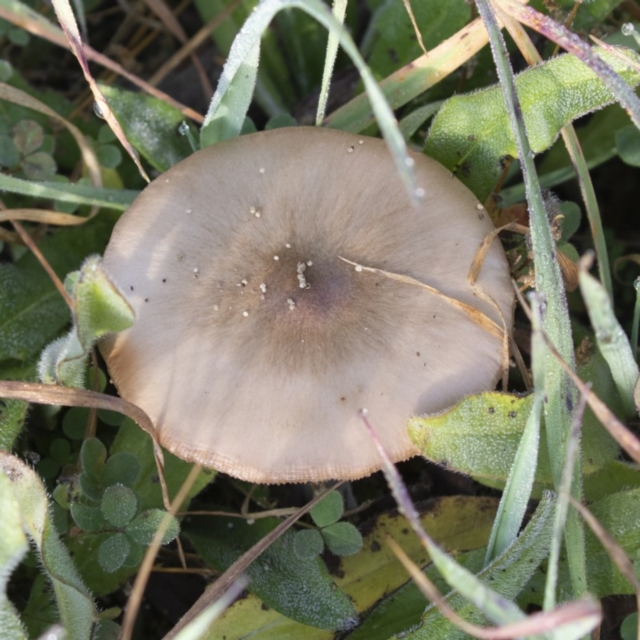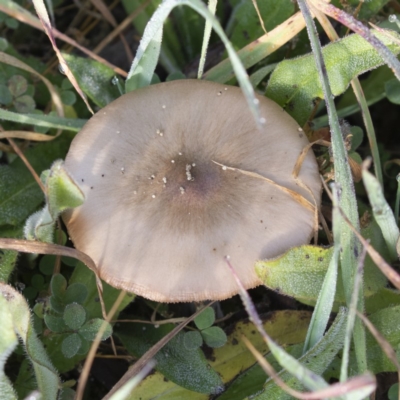Pluteus cervinus (Pluteus cervinus)
<p class="MsoNormal" style="margin-bottom: .0001pt; line-height: normal;">The fruitbody is a mushroom with the cap held atop a central stem. The cap is dark grey-brown to brown, up to 15 centimetres in diameter and with some radial fibrils but in general more-or-less smooth. The cap is initially convex to hemispherical but flattens with age though often a central hump (or <strong>umbo</strong>) remains. The gills are initially whitish and become pinkish as the spores mature. Technically they are described as <strong>free</strong>, which means that none of them reach the stem, so you see a gill-free channel around the top of the stem. The whitish to pale brown stem may be up to 10 centimetres long and up to 2 centimetres wide at the broader base</p>
<p class="MsoNormal" style="margin-bottom: .0001pt; line-height: normal;"> </p>
<p class="MsoNormal" style="margin-bottom: .0001pt; line-height: normal;">There is neither a partial veil nor a universal veil.</p>
<p class="MsoNormal" style="margin-bottom: .0001pt; line-height: normal;"> </p>
<p class="MsoNormal" style="margin-bottom: .0001pt; line-height: normal;">Spore print: pinkish to brownish-pinkish</p>
<p class="MsoNormal" style="margin-bottom: .0001pt; line-height: normal;"> </p>
<p class="MsoNormal" style="margin-bottom: .0001pt; line-height: normal;">The mushrooms grow from soil, woodchips or rotten wood; in woodlands, forests or suburban gardens. The species has been reported from nay countries.</p>
<p class="MsoNormal" style="margin-bottom: .0001pt; line-height: normal;"> </p>
<p class="MsoNormal" style="margin-bottom: .0001pt; line-height: normal;"><strong>Look-alikes</strong></p>
<p class="MsoNormal" style="margin-bottom: .0001pt; line-height: normal;"> </p>
<p class="MsoNormal" style="margin-bottom: .0001pt; line-height: normal;">Species of <em>Volvopluteus</em> also have free gills and give a similar coloured spore print, but in that genus you find a universal veil which leaves a remnant as a cup-like volva around the base of the stem.</p>
<p class="MsoNormal" style="margin-bottom: .0001pt; line-height: normal;"> </p>
<p class="MsoNormal" style="margin-bottom: .0001pt; line-height: normal;">Other genera with similar spore prints are <em>Entoloma</em>, <em>Clitopilus</em> and <em>Rhodocybe</em> but in those genera the longer gills are attached to the stem (so there is no gill-free channel around the top of the stem).</p>
<p class="MsoNormal" style="margin-bottom: .0001pt; line-height: normal;"> </p>
<p class="MsoNormal" style="margin-bottom: .0001pt; line-height: normal;">In <em>Agaricus</em> the gills are free and are initially pinkish but become brown as the spores mature (and the spore print is a dark chocolate brown). Furthermore, in <em>Agaricus</em> you find a partial veil, which leaves a ring-like or skirt-like remnant around the upper half of the stem. </p>
<p class="MsoNormal" style="margin-bottom: .0001pt; line-height: normal;"> </p>
<p> </p>
<p class="MsoNormal" style="margin-bottom: .0001pt; line-height: normal;">It is possible that there is more than one <em>cervinus</em>-type species in Australia, but for now it is simplest to label any such sightings as <em>Pluteus cervinus</em>. </p>
<p> </p>
Pluteus cervinus is listed in the following regions:
Canberra & Southern Tablelands | South Coast
Species information
- Pluteus cervinus Scientific name
- Pluteus cervinus Common name
- Not Sensitive
- Local native
- Non-invasive or negligible
- Machine learning
Location information
-
Maps
Bodalla State Forest






